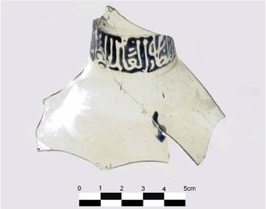The Arabs
The presence of Arab goods in the complex of the Palace of Baldu raises questions concerning the socioeconomic relations between the Islamic world and Sardinia, at a time when the Mediterranean basin was a place of intense exchanges between western and eastern states.

The Arab nation was born in the seventh century when Muhammad founded Islamic religion under which all people that joined it were politically unified. At his death in 632 A.D., the state expanded through rapid conquests which affected Persia, Palestine, Syria, Egypt, the coast of North Africa, Spain, reaching the French lands where the Islamic advance was defeated in 732 (fig. 2).

After the conquest of the African coast in the late seventh century, Sardinia, still ruled by Byzantium, became a useful territory for the expansion of Islam.
The Arabs exploited the Island’s ports in order to reach Andalusia and the Maghreb and the natural resources required for continuing their military operations and sustain the already occupied regions; the island was also forced to pay the Giz'yah, i.e. a type of ransom for persons and goods. In Sardinia, the Arab invasions definitively ended in the early eleventh century, thanks to the intervention of Pisa and Genoa, when it had already declared its independence by setting up the four Giudicati.
Thereafter, separate states were created from the debris of the Islamic empire: the ethnic element mingled with that of the subjugated populations, remaining present in the Mediterranean and the Near East until the thirteenth century, when it ended because of the Mongolian invasion (fig. 3); the XVI-XVIII centuries mark the economic and spiritual decline of the Arab world.

Bibliografia
- P. FOIS, Il ruolo della Sardegna nella conquista Islamica dell’occidente (VIII secolo), in Rivista dell’Istituto di Storia dell’Europa Mediterranea (CNR), 7, 2011, pp. 5-26.
- F. PINNA, Le testimonianze archeologiche relative ai rapporti tra gli Arabi e la Sardegna nel medioevo, in Rivista dell’Istituto di Storia dell’Europa Mediterranea (CNR), 4, 2010, pp. 11-37.
- F. PINNA, D. CORDA, Scambi e circuiti commerciali nella Sardegna medievale: dati archeologici dal Palazzo di Baldu (Luogosanto, Olbia-Tempio), in Bulletin de la Société des sciences historiques et naturelles de la Corse, 2014, pp. 748-749.
- F. PINNA, D. MUSIO, Il vetro nella Sardegna medievale: nuovi dati dall'indagine archeologica del Palazzo di Baldu (Luogosanto, OT), in A. COSCARELLA (a cura di), Il vetro in Italia: testimonianze, produzioni, commerci in età bassomedievale. Il vetro in Calabria: vecchie scoperte, nuove acquisizioni, XV Giornate di studio sul vetro AIHV (Arcavacata di Rende, 9-11 giugno 2011), Arcavacata di Rende 2012, pp. pp. 315-329.
- M. G. STASOLLA, La Sardegna nelle fonti arabe, in P. CORRIAS, S. COSENTINO (a cura di), Ai confini dell’impero: storia, arte e archeologia della Sardegna bizantina, Cagliari 2002, pp. 79-98.
- C. ZEDDA, Bisanzio, L’Islam e i giudicati: la Sardegna e il mondo mediterraneo tra VII e XI secolo, in Archivio Storico Giuridico Sardo di Sassari, n.s., X, 2006, pp. 39-112.
- C. ZEDDA, R. PINNA, La nascita dei Giudicati. Proposta per lo scioglimento di un enigma storiografico, in Archivio Storico Giuridico Sardo di Sassari, 2008, pp. 27-118 (solo in versione on-line in http://www.archiviogiuridico.it/instampa.htm).

 VR
VR